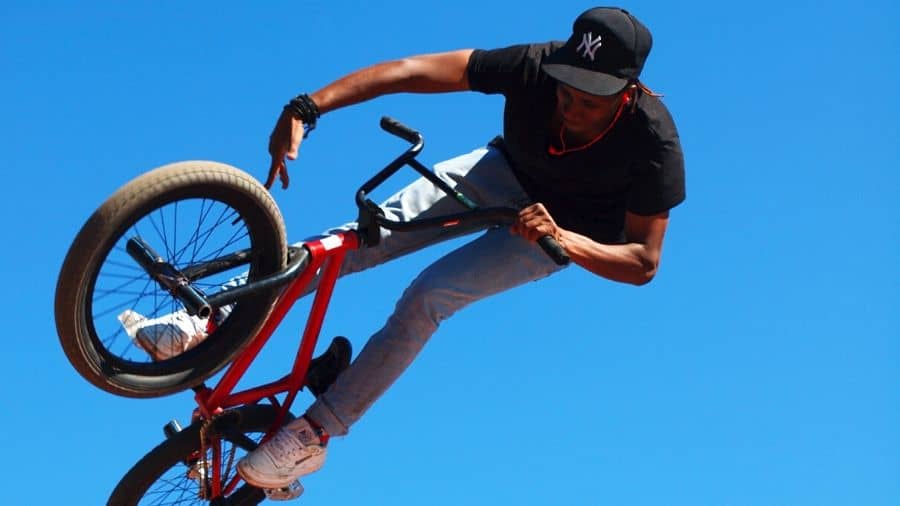
Have you watched the Olympic BMX racing or skatepark videos of BMX riders pulling crazy stunts and wondered why their seats point up? Maybe you’ve seen a few BMX riders cruise past and noticed their inclined saddles. If you’re curious to know why this is, I’ve got the answer for you.
BMX seats point up to improve the riders’ control of the bike when performing tricks and in racing, using it to pivot and lever the bikes over jumps and through the air. Having a pointed up saddle is also for comfort as it gives riders more clearance when pedaling.
Not every BMX seat in the world is pointed up at an angle, but many riders prefer a slight incline. In this article, we’ll look at exactly why this is and look in more detail at the BMX saddle.
Table of Contents
Reasons Why BMX Seats Point Up
If you love cycling, you’ll know that road and mountain bikes differ greatly from BMXes, because their riding function and styles are completely different.
Road and mountain bikes require the rider to sit to pedal the bike into motion. Generally speaking, those types of bicycles can’t perform any of the stunts nor can they can ride over the same obstacles as BMXes.
Flying over jumps, sprinting incredibly quickly and performing jaw-dropping tricks, BMX riders needs to be able to manoeuvre their bikes into a multitude of positions and angles on the ground – and in the air.
In order to perform those, the BMX riders position their bike’s seats as low as possible for clearance over the frame and pointing the seat up allows the rider to grip and grab the seat to help them pivot and whip the bike around in outrageous positions to perform their gravity-defying tricks.
Another reason why BMX seats point up is that they allow the rider to protect themselves from sliding forward onto the handlebars and also to prevent themselves from slamming into the bike’s frame when pulling off tricks.
For cruising around on a BMX having a saddle that’s tilted up will also allow more clearance and leg room when pedaling. Most BMX seats are lowered right down to the ground, and so in the same way, if you sat on a small chair, you would feel more comfortable leaning back a little and stretching your legs, the same principle can be applied by angling the BMX seat back.
What are the Types of BMX seats?
For a part of a bike that sees such little riding action, BMX seats have evolved dramatically over the past few years. Due to the different BMX disciplines, seats play different roles and serve different functions. When it comes to seats, durability and comfort remain the first and foremost consideration.
There are five general types of BMX seats and the manner in which the seat posts fit the frame, and they suit specific types of riding. There are five main fitment types:
- Pivotal: This is the latest innovation in BMX seat types. Used only in conjunction with a pivotal seat post, it comprises a specially moulded cup shape with a series of adjustment grooves wherein the seat is placed. A single bolt slides between the two parts through the top of the seat.
- Integrated: This is the most common BMX seat type. In this type, the seat and seat post are assembled as one unit and cannot be separated.
- Standard: With a fitment that’s pretty basic, this type of BMX seat and seat post fitment is fast being phased out because riders find it to too obstructive when trying to grip the seat with their thighs during stunts.
- Tripod: Another of the latest technologies derived for BMX seats, the tripod seat type is made up by a triangular plate at the top of the seat post, offering the seat three points of support for enhanced durability.
- Railed: Familiar with road and mountain bikers, the railed BMX seat type is popular with riders because of its micro-adjustment settings. Riders can fine-tune their seat position and angle thanks to a twin-rail design clutched between plates that slide on the rails. Setting the seat post along the rails is easy, and super fidgety.
What are BMX Seats Made of?
BMX seats are made from molded plastic hull, polyurethane foam padding and synthetic material or leather covers.
Additionally, BMX seats feature a plastic bumper on seat noses and along the sides to protect them against impacts. Road and mountain bikers traditionally favour leather for their enhanced comfort and durability, and this is also true of BMX seats.
Seat posts range in materials from steel, chromoloy and aluminium, while racing BMXes features carbon fiber seat posts for even further weight-savings.
Are BMX Seats Comfortable?
Comfort and durability are the most important aspects of BMX seats. Just as with the paint scheme and colors of BMXes, seats are the most customizable component. Three key parts of a BMX seat dictate its comfort and specific need for different riding styles: width, padding, material.
Seats are available in three widths: slim; mid-width; and fat. BMX racers favor slim width seats because they don’t get in the way of the pedaling, while mid-width seats are the go-to choice of freestyle riders for they offer plenty of grip between the thighs for performing stunts while not feeling obstructive.
Fat width seats are usually selected for street and freestyle riders seeking added comfort and even more grip for pulling off gnarly no-hands tricks.
Two types of seat padding offer impact protection and support to riders: gel materials and polyurethane padding. Differing amounts of padding of each type are available, and the type of padding is up to personal preference. Both offer excellent levels of comfort and impact absorption. While BMX seats are truly designed for all-day riding comfort like road and mountain seats, thick padding will go a long way in transforming BMX rides from short stints to hours-long sessions.
Covers add personality and style to every seat – and finish off the overall look of BMXes. Three materials are most common, all offering excellent durability and comfort: nylon, vinyl and leather.
Available in any color of the rainbow, with prints in a multitude of styles, or minimalist designs, the seat cover does not only play an aesthetic role but also aids in making seats easier to grip and non-slip when grabbed by the rider’s thighs.
What is the Best BMX Seat Post Height?
As with all sports, and especially in cycling disciplines, trend play a large role in component design. When BMX was born, seat posts were set in line with the top of the handlebars. Over the last decade, seat post heights have dropped so low that large numbers of freestyle and flatlands BMX riders removed their seat posts all together for what is termed a ‘slammed’ style. However, seat post heights have been creeping back up with the majority of riders now sporting at least a fist-sized gap between their seats and their frames.
As stunts grow ever bigger and tricks bolder, raised seat post heights plays a larger role in providing support to riders on heavy landings, while the BMX seats pointing up protect the riders from sliding forward during jumps and airborne-stunts – it makes so much sense!
My Favourite BMX Seats
- Velo BMX Gel Saddle (Amazon Link)
- Answer BMX Pivotal Seat Black (Amazon Link)
- Da Bomb NEW SKULL 2.0 BMX Saddle (Amazon Link)
